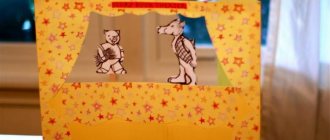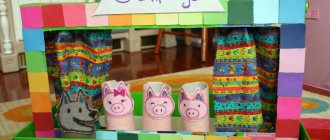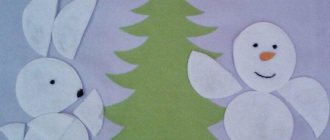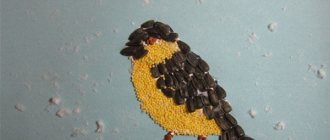Basic principle: how it works
The basis of such theater is “playing” with shadows. The performance is created by light sources. The figure or object is illuminated and a shadow appears on the screen. That is why creating such a theater with your own hands will not be difficult.
Black and white representations are not the only option. Scenes can be “painted” in different colors. You will need colored light bulbs or filters that are attached to the light source. For example, for an evening city scene - a dark blue filter, for a morning scene - shades of yellow.
Stages of creating a shadow theater
Making a shadow theater for children with your own hands combines two stages: preparing the stage and creating characters. The approximate time that needs to be spent is about 30-40 minutes. But if you start decorating and creating puppet characters, it will take a little more time.
For the theater to “work”, you will need:
- Choose a suitable light source.
- Make a screen out of a sheet, whatman paper or white paper.
- Take care of the frame (made of cardboard or an artistic stretcher).
- Correctly position the light source, screen and characters.
Stage and scenery
If you use puppets in the performance, then you should decide on the stage on which the performance will take place. For example, it can be made from a large rectangular box: a large hole is cut out in it, which is then sealed with a white sheet of paper.
Also, shadow theater looks more impressive if you use decorations. They can be cut out of paper and attached along the edge of the screen.
At the same time, it is important that, on the one hand, the scenery is clearly visible, and on the other, there is enough space left for the characters in the play in the center of the screen.
Thus, shadow theater in kindergarten is not only an element of entertainment for children, but also an element of their own creativity, as well as a component of the child’s education and development system. In addition, activities of this kind stimulate the emotional sphere of children - emotions accompany both the process of preparing a performance, making characters and scenery, and the plot of the play itself. The curtain, of course, adds an additional effect to the performance.
Selecting a lighting fixture and a suitable screen
When creating a shadow theater with your own hands, you need a light source: an ordinary flashlight, a table lamp or any other adjustable lamp. You can even use mobile phone lighting.
A translucent white plane is used as a screen. The size is not limited - it all depends on the light power. For the screen, materials that are at hand are suitable: tracing paper, a thin white sheet or a simple Whatman paper. And if this is not the case, you can fasten sheets of snow-white paper together.
To make the scene look more impressive, you will need a frame for the screen. It is made from an artistic stretcher or cardboard. For example, a do-it-yourself shadow theater for children is done this way: choose a suitable box and cut out the bottom.
Then take parchment paper, cut it into a rectangle and stick it to the bottom of the box. All that remains is to decorate the layout as you wish. You can also stretch fabric over a small frame.
Instructions for making dolls
A sketch is made on thin cardboard, from which the head of the future character is cut out. Using glue or a paper clip (you can also use a needle and thread), a paper tube for the index finger is attached to the head - together they form the body of the doll. In turn, the puppeteer's middle and thumb become the character's feet. In this case, it is better to make the figures in such a way that their heads and limbs are moving - this will make the shadow theater for children more dynamic and emotional.
Then you need to make punctures in the parts and thread pieces of wire into them, twisting them on both sides in a spiral. In order to make eyes for a doll, punctures are also first made, the holes of which are subsequently expanded with some pointed object (an awl, a knife, etc.). A circle cut from colored transparent film is glued to the hole. Then the doll's parts are covered with black paint.
Characters for the theater
Shadow theater varies depending on the characters. There is, for example, finger theater - shadows from hands are used. The fingers are folded to form the desired ones. This kind of theater is good for children - it develops hand motor skills. For such performances, a small “stage” is suitable.
The puppet theater looks bigger. This implies a performance with additional decorations and figures. Stencils can be used to create a shadow theater with your own hands for children. The size of the dolls is approximately 10 cm (height and size can be easily changed due to distance and approach).
The figures are created from cardboard, fixed on wooden skewers or also on cardboard. You can do it differently: cut out paper figures and stick them on cardboard. It is important to coat the material with glue, but not generously, so that the base does not deteriorate.
The dolls need to be dried under pressure, and then additionally coated with a layer of PVA glue on top. A semi-dry brush is required. It is advisable to paint cardboard dolls with black paint - they will be more noticeable.
Using additional funds
If the performance is aimed at children in the older group of kindergarten, it is possible that the finger shadow theater will captivate them less. Still, this activity is more suitable for kids. How to make shadow theater more vivid and memorable? In this case, it is possible to use additional funds. So, for example, if we are talking about a performance in an educational institution, and not about a family evening at home, it is better to use a real, professional screen.
The characters for the performance can be either ordinary dolls or silhouettes specially made from various materials. In this case, it is better to choose black material for cutting out characters. It is better to attach the cut out silhouettes to sticks. You can complicate the action by using more mobile forms. For example, these could be articulated dolls that move using special ropes.
Position of screen, light source and characters
The screen is placed between the audience and the lighting fixture. The light source is placed slightly to the side, not too close to the screen itself. Then the shadows will be clearer. Distance – about 25 cm.
The shadow changes depending on the distance between the figure and the light source. To make the wolf, for example, appear larger, you need to move the character further away. For the first productions, it is advisable to use a few characters - two or three are enough. With practice, you can create more complex representations.
Complicated version
You can create a shadow theater for children using templates with your own hands in half an hour, but if you have more time, it’s worth thinking through additional details. For example, add decorations. They are created from cardboard and attached tightly to the screen using tape or paper clips. Then the decorations will not fall unexpectedly.
It’s easy to “revive” the figures - make them more mobile using soft wire. It is used to wrap arms, legs, wings and other parts.
It’s easy to “play up” an evening with a performance: decorate the curtain and draw bright tickets. And if several performances are planned, print out programs for spectators. And, of course, you need an intermission, during which you can treat the audience to delicious home-cooked food.
Scene selection
The best place to start is with folk tales. They have a simple plot and not many characters. By the way, in China, where shadow theater comes from, up to a thousand figures could be used during one performance.
Before giving a performance, you need to understand the mystery of shadow theater. For example, in order for a doll to disappear unnoticed (or suddenly appear), you need to turn it with its edge towards the screen and remove it.
Before giving a performance, you need to learn the secrets of shadow theater. For example, in order for a doll or decoration to disappear unnoticed (or suddenly appear), you need to turn it edge-on towards the screen and move it.
So that the audience does not languish while waiting for the “actors,” the dolls must be arranged in order in advance. When creating a theater on sticks with your own hands using a template, it is worth adding additional effects - sound. You just need to choose the right music. And if you move the light source, you can depict bad weather, a storm or snowfall.
Shadow theater has not changed much since ancient times. The lighting setup and use of silhouettes are exactly the same. But now for home performances it is much easier to find and print the necessary stencils. And in the past, dolls were created by masters who worked on the figures down to the nuances.
MAGAZINE Preschooler.RF
The mystery of shadow theater or the art of shadow controlGribova E.V.
annotation
The room is dark, but suddenly the light comes on and rests on the screen of a white sheet, the curtain is already open, and the first silhouette appears on the improvised stage and the fairy tale comes to life... Shadow theater is the integration of artistic images, original design, text voice acting and musical accompaniment, allowing children to have an exciting form to get acquainted with this type of art, promoting the development of speech, the manifestation of imagination, encouragement for active interaction and communication, the formation of aesthetic taste and familiarization with culture.
The theater has a great future, like everything that has a great past.
Karel Capek
The organization of theatrical activities in a preschool educational institution is important in socialization, increasing the level of general development, establishing communication with peers and adults, developing artistic abilities and creative potential, aesthetic sense, artistry, articulation apparatus, speech activity and emotional responsiveness. Passion for theater can be an excellent way to overcome timidity, shyness and self-doubt; In productions, every child is able to find the embodiment of fantasies and a reflection of their worldview.
Among the many types and subtypes of theater (tabletop, floor, bench, horseback, finger, mitten, spoon, paper, magnetic, living puppet theater, etc.), shadow theater occupies a very special place - it is often the most mysterious and spectacular for children, at the same time theater that is accessible and easy to implement for teachers. A simple and exciting activity that includes the mystery of light and shadow, preamble and presentation, people and figures, the movement of hands and silhouette puppets... The scope for imagination is almost unlimited: you can tell well-known stories (play out performances based on fairy tales, fables, small plays) and take well-known characters as a basis, and invent new stories with unknown characters.
As a form of visual art, theatrical shadow activity originated in China over 1.7 thousand years ago. [1] Initially, performances took place on the street at night, and oil lamps were used as a light source. Traditionally, the puppets, which rested against a translucent screen from the back, were made of thin leather, paper or cardboard. Depending on the material, they had different types of fastening: solid figures were attached to wooden or metal sticks, and those made up of separate, movably connected parts were attached to more complex structures. By the second millennium, shadow theater, in addition to China, became widespread in India and other regions of Asia; in 1767, the technology of this theater was brought home by the French missionary Jules Alod. 7 years later, the poet Goethe independently staged a performance in Germany, and after another 2 years the art reached Great Britain. In Russia, shadow theater appeared at the turn of the 17th-18th centuries. during the reign of Anna Ioannovna, within the framework of school theaters in theological seminaries and academies. The specifics, aesthetics and themes of shadow theater vary depending on traditions and situations, but the most famous and most influential to this day remains the Tangshan shadow theater. [2]
If earlier this type of art, due to the high cost of making puppets, was available only to rich people, now it can be turned into an exciting activity for children. To do this, you only need a plane-screen made of a light translucent material (fabric or paper), a directional light source (an ordinary fluorescent lamp, a flashlight, and even a mobile phone with the corresponding function will do), objects that act as “artists” (for example, paper figures dark color on wooden sticks). The screen itself is hung or placed between the intended viewers and the light source; shadow-casting figures are located between the screen and the lamp.
To begin with, you can invite children to identify light sources (what kind of light there is, what it gives, what comes to replace the day), flip switches, turn flashlights on and off, etc. Find and name natural and artificial light sources - chandeliers, car headlights, lanterns , New Year's garlands, light bulbs, gas on the stove, fireworks in the sky, candles, bonfires, sun, moon, stars, fireflies, etc. Discuss that day gives way to night, the sun in the sky gives way to the moon; realize that a switched-on chandelier can be turned off, and a lit candle can be blown out. Using a regular flashlight, you can determine what affects the brightness of the light source by changing the distance and strength (the flashlight is closer or farther, more or less light bulbs are on); shine the light on different objects and observe what shadows they cast and at what angle. Conduct an experiment to see whether the light of a flashlight passes through paper, glass, thick fabric, water, etc.
To interest and prepare children, you should first watch together and discuss a short cartoon about how fun it is to play with shadows; for small children, the series Luntik and his friends [4] is better suited; for older children, the educational cartoon Fixiki [5]. The full-length cartoon by the French animator Michel Ocelot, drawn in an exquisite silhouette manner and a peculiar shadow technique, “Princes and Princesses” and its sequel “Dragons and Princesses” [6] may seem interesting.
For modern children, who spend a significant part of their time in front of the screens of phones, tablets, computers and other devices, you can select thematic applications - for example, “Papaton Shadow Theater - puppet fairy tales for children and their parents” [8], which can be downloaded from the App Store and install on iPhone, iPad. Many corresponding applications with different options and degrees of complexity are also installed on Android from the Play Store (for example, Figure 1).
Picture 1
A child’s simple pastime at the computer can also be made interesting without any specialized ICT programs. To do this, you need to go to the Internet, select the images you like in any search engine, save them on your desktop, open them using the Paint program (Figure 2), in which you can not only process, but also create graphic files. Next, you need to do a little magic , namely, make a black (silhouette) fill, and after that you can send them to print. All that remains is to cut out the selected objects and either decorate the screen with them, or “put” them on sticks for direct participation in the performance.
Figure 2
Now it’s time to move directly to the mystery of the shadow theater, but before making silhouette figures for a full-fledged performance, you can experiment with shadows from various objects (Figure 3).
Figure 3
It is recommended that children begin to get acquainted with this type of theatrical art starting from 1.5-2 years of age. In this case, the first classes should be held exclusively as a theatrical performance, performed in front of small spectators by already experienced “actors” . And only after the child understands the rules, becomes familiar with the traditions and features of the shadow theater, can he or she be included in the performance as an active participant in the action, given the opportunity to voice roles, move the scenery and even “direct” the hero figures. Naturally, you should start with small episodic roles and gradually increase complexity.
To create a real theatrical atmosphere in the room, you need to dim the lights a little. A large white sheet of paper, tracing paper, Whatman paper, or a piece of white fabric, depending on the desired size, can serve as a screen screen. Curtain curtains on the sides and a narrow lambrequin along the top crossbar can significantly transform the screen (Figure 4). Or decorate a screen for a TV screen. It’s easy to make a small screen from an ordinary shoe box by carefully cutting out the bottom. In this case, the front side can either be painted or decorated.
Figure 4
In the event that the role of “artists” is to be played by shadows appearing on the screen from different positions of the hands and interlacing of fingers, then it is first necessary to practice folding them correctly (Figure 5). After static figures have been mastered, you can begin to “revive” the characters - to do this, just move your fingers, and the hare will move its ears, the fox will open its growth, and the bird will flap its wings. This activity is not only exciting, but also useful - it develops fine motor skills of the fingers, spatial thinking and imagination. For inspiration, you can also watch videos of performances by finger shadow theater professionals. [3]
Figure 5
If “silhouette figures” , then they can be made from scrap materials: paper or cardboard, pencil, paper knife or scissors. There are also several options here: print the images on a printer and cut them out along the contour, draw them yourself, or use ready-made stencils. For reliability during repeated use, the silhouettes are laminated or initially made of thick cardboard for rigidity. It is convenient to secure the finished figures using a glue gun, electrical tape and/or tape, like on thin sticks (cocktail tubes or wooden skewers as in Figure 6), which are convenient to hold at a distance from the screen (usually this is done with the main characters of the show), so it can be done on flat bases, which is rational if the figures are not expected to move frequently along the screen (they can be placed on a flat base and left without human intervention, for example, to decorate the scenery or create an entourage: trees, houses, curtains, table, etc. .d.).
Figure 6
Helpful Tips:
- the smaller the screen, the thinner and more transparent the material used for its manufacture should be and the brighter the light source needed;
- the performance can be performed both with the help of “heroes” on sticks, and silhouettes assembled from fingers and palms;
- it is important to correctly install the light source, namely so that the shadow from the figures/hands falls directly on the screen (Figure 7 below);
- for the shadows to be clear, the light should fall directly (not from the side), and the lamp should stand 2-3 meters from the wall (not close);
- so that static decorations do not move during the performance, they must be securely attached to the screen itself (for example, using double-sided tape, buttons or paper clips);
- you need to ensure that the silhouettes of those holding the figures do not appear in the rays of the light source, otherwise they will also be visible to the audience;
- It is worth remembering that the closer the “heroes” are located to the light source, the larger they will become on the “stage” , and, accordingly, the closer the character is to the screen, the smaller he will become;
- In order for silhouette figures to be contrasting and noticeable on the screen, it is better to make them black or very dark;
- You can add color to the performance using colored light bulbs or special filters; blue is suitable for night scenes; red or orange is suitable for morning scenes;
- it is a priori impossible to hold all the heroes in the hands, so it would be reasonable to provide the opportunity to secure them at the base of the “stage” ;
- in the first productions it is not recommended to use more than two or three characters; only after training should you begin performances with a large number of characters;
- you can complicate the production by using movable silhouette figures; to do this, you need to assemble the “heroes” in parts, and then attach the limbs (arms, legs, tails, wings) and other movable fragments to the body, for example, using thin wire;
- in order for the audience to understand which character is speaking at the moment, he must move, and those who are silent must not move;
- It’s better to learn the roles by heart: firstly, this is memory training, and secondly, reading from a piece of paper in the dark is quite difficult;
- the duration of the performance should vary depending on the age of the actors and the intended audience: the younger the children, the shorter the production;
- the repertoire must be selected based on the number of different heroes, so that there is more action and a change of “characters” behind the screen.
Figure 7
Dramatization is often the final stage of studying any literary work. Additional action is a careful selection of musical material and music library for the planned production; voicing “characters” contributes to the formation of children’s speech culture, the ability to consciously and correctly use all components of intonation. You can create a theatrical atmosphere by doing another type of children's activity - visual arts, drawing tickets and making a program (Figure 8). The theater is allowed to begin not with a hanger at all, but with familiarization with the poster for the upcoming performance. During the performance itself, it would be great to have a real intermission with an impromptu buffet, and end the break with traditional bells calling for the start of the second part of the performance.
Figure 8
You can discuss what you see and carry out reflection in an equally creative form - for example, when making a thematic lapbook “shadow theater” (or, in other words, folding books with all kinds of pockets, doors, windows, envelopes, tabs and moving parts, combining materials according to what something about the topic). The laptop simultaneously provides playful, educational, artistic and creative activity for children; It is also convenient to store prepared props, silhouette figures, performance programs and entrance tickets for it (Figure 9).
Figure 9
It is also worth considering that Moscow has its own children's shadow theater (Moscow State Budgetary Institution "MDTT" ) on Izmailovsky Boulevard [7], which uses the techniques of Chinese shadow theater in its work. The founders, or rather its founders, 74 years ago were the artist Ekaterina Sonnenstral and the director Sofia Svobodina. There is an opportunity to take children to a performance where actors-storytellers are organically combined with puppet and shadow theater, or invite a professional to perform a performance at a preschool educational institution, where they will show their magic to young spectators.
Shadow theater is an action where you can simultaneously play the role of an “artist” , screenwriter, decorator, director and stage manager. Thanks to the ability to cut out almost any silhouette figures, shadow theater is a boundless field for the boundless flight of children's imagination, simultaneously forming a strong interest in theatrical activities in general. Within the framework of such classes, several educational areas are integrated at once - cognition, communication, socialization, artistic creativity. Introducing children to theatrical activities has a beneficial effect on the development of personality, individuality and aesthetic potential; the child becomes liberated, gets the opportunity to express his feelings and resolve internal conflicts, conveys creative ideas and receives satisfaction from the process.
Bibliography:
- Lin Li, Delightful Shadow Theater / TIANSHANNET. [Electronic resource]. URL:
- Chinese shadow theater / CCTV-com. [Electronic resource].
- Ombres chinoises - Shadow Theater. [Electronic resource].
- Luntik and his friends - episode 207. Shadow [Electronic resource].
- Fixies – Shadow Theater | Educational cartoons for children and schoolchildren [Electronic resource].
- Ivan Tsarevich and the fickle princess [Electronic resource].
- Moscow Children's Shadow Theater (Moscow State Budgetary Institution “MDTT” ) / Official website [Electronic resource]. URL: http://www. teniteatr. ru/ (date of access: 01/31/2018)
- Application for iPhone and iPad “Papaton Shadow Theater – puppet fairy tales for children and their parents” / App Store [Electronic resource]. URL:
| Next > |











